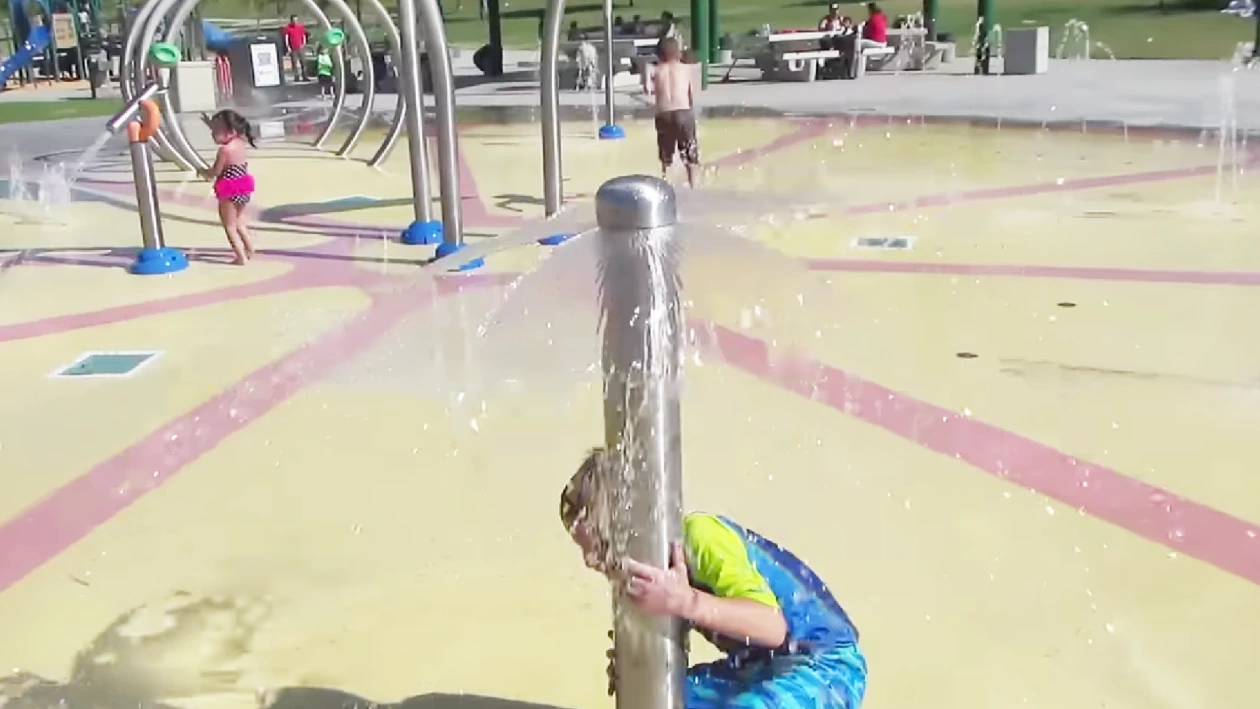Are Splash Pads Safe Game for Kids in Summer?

Discover the thrilling world of splash pads, where children’s laughter mingles with the refreshing splash of water.
Are these vibrant water playgrounds truly safe havens for playful kids, or do lurking dangers await the unwary guardians?
Dive into the depths of the debate to uncover the secrets of splash pad safety.
Are Splash Pads Safe Games for Kids?
Splash pads can be a safe option for kids to enjoy water play. They have interactive water features that eliminate standing water, reducing the risk of drowning.
However, there are potential risks such as the spread of germs if water is not treated properly and an increased risk of fall-related injuries on wet surfaces.
To ensure safety, constant parental supervision, regular bathroom breaks, water shoes for protection, and staying home when sick are recommended.
Properly operated and regulated splash pads can minimize the chances of unsafe water experiences.
Maintaining proper hygiene and water treatment protocols is crucial to ensure a safe environment for kids.
Despite risks, with proper supervision and precautions, splash pads can provide a fun and safe water play experience for children.
Check this out:
Introduction To Splash Pads As Safe Water Play Option
- As summer approaches, splash pads have emerged as a popular alternative to swimming pools for families seeking ways to cool off and have fun.
- Splash pads offer interactive water features that eliminate standing water, reducing the risk of drowning for young children compared to traditional pools.
- Parents find splash pads appealing as they provide a safe and enjoyable water play experience for kids during the hot summer months.
Interactive Features Ensure Safety For Kids
One of the key aspects that make splash pads a safe water play option for kids is their interactive features.
Splash pads are designed with various water features such as water jets, sprays, and fountains that encourage engagement and play while eliminating deep water areas that could pose drowning hazards.
These features offer a delightful and cool experience for children of all ages, allowing them to have safe water fun without requiring any swimming skills.
This interactive setup not only enhances kids’ enjoyment but also reduces the risks commonly associated with traditional swimming pools.
Concerns About Germ Spread On Splash Pads
While splash pads provide a safer alternative to pools in terms of drowning risks, there are concerns related to the spread of germs in these water play areas.
Without proper treatment and maintenance, the water in splash pads can become a breeding ground for bacteria and viruses, potentially causing illnesses among children and families who use the facility.
To address this issue, splash pad operators must adhere to strict water treatment and sanitation protocols to maintain clean and safe water for all users.
Wet Surfaces Heighten Fall Risk
- Safety Concern: One important safety consideration regarding splash pads is the presence of wet surfaces, which can heighten the risk of fall-related injuries among children.
- Risk Factors: The continuous splashing and running water can lead to slippery conditions, increasing the chances of kids losing their footing and experiencing minor injuries such as bruises or sprains.
- Preventive Measure: Parents can help mitigate this risk by ensuring their children wear suitable footwear like water shoes that provide enhanced traction on wet surfaces. This significantly reduces the probability of slips and falls while playing.
Importance Of Parental Supervision
One of the most critical safety measures for splash pads is constant supervision by parents or guardians.
Splash pads are designed with safety in mind; however, active parental supervision is essential to ensure that children are following the rules, playing safely, and not engaging in any risky behaviors that could lead to accidents or injuries.
Staying vigilant and attentive, parents can create a safe environment for their kids to enjoy the water play experience without putting themselves at unnecessary risk.
Encouraging Regular Bathroom Breaks
- Parental supervision is crucial for safety at splash pads.
- Regular bathroom breaks are essential for children to avoid accidents in the water.
- Encouraging and monitoring bathroom breaks helps maintain a hygienic environment at the splash pad.
- Taking breaks helps minimize the risk of contamination from urine or fecal matter in the water.
Consideration Of Water Shoes For Added Protection
To enhance the safety of children on splash pads, parents should consider outfitting them with water shoes.
These shoes offer additional protection and grip on wet surfaces, reducing the risk of slips and falls during play.
Water shoes are specially designed to drain water quickly, offer traction on slippery surfaces, and shield children’s feet from sharp objects or rough surfaces often present in splash pads.
By investing in quality water shoes, parents can safeguard their kids from foot injuries and improve their water play experience.
Stay Home When Sick
In light of the ongoing concern surrounding the spread of germs, parents must adhere to the practice of keeping sick children at home and away from public water play areas like splash pads.
Illnesses like stomach bugs or respiratory infections can easily spread in water environments, putting other children at risk of contracting the same illnesses.
By prioritizing the health and well-being of all users, parents can contribute to maintaining a safe and hygienic environment at splash pads and prevent the unnecessary spread of infections among children.
Regulation For Safe Splash Pad Operation
To ensure that splash pads continue to provide safe water experiences for children, operators need to adhere to established regulations and guidelines for operation.
Proper maintenance of water quality, routine inspections of equipment, and adherence to safety protocols are crucial aspects of operating a safe and hygienic splash pad facility.
By implementing and enforcing these regulations, splash pad operators can minimize risks, promote a positive water play experience, and instill confidence in parents regarding the safety of these recreational facilities.
Conclusion: Maintaining Safe Water Experiences
The splash pads offer a fun and refreshing water play option for kids during the summer months. Ensuring their safety requires a combination of proactive measures and responsible behavior.
“Parents play a crucial role in maintaining a safe and enjoyable water play experience for their kids.”
By prioritizing safety, following recommended guidelines, and staying informed about best practices, families can continue to embrace splash pads as a safe and exciting summer activity for children.
FAQ
Are splash pads safe for kids?
While splash pads may offer a fun way for kids to cool off during hot days, it’s important to be aware of the potential risks they pose. The standing water in splash pads can serve as a breeding ground for bacteria, which could potentially make children sick if proper sanitation measures are not in place. Parents should be cautious and ensure that the splash pad they visit maintains proper cleanliness and hygiene standards.
To mitigate the risks associated with splash pad visits, parents should supervise their children closely, encourage them to practice good hygiene habits, such as washing their hands before and after playing, and avoid drinking water from the splash pad.
What are the cons of splash pads?
One potential drawback of splash pads is the increased risk of slips and falls, as children run and play on wet surfaces. This can result in minor injuries such as bumps, bruises, scrapes, or cuts, adding a safety concern to the fun water play experience.
Additionally, the slippery nature of the splash pad surface may also pose a risk for more serious injuries if children are not careful while engaging in water activities.
Are splash pads safer than pools?
While splash pads offer a safer water play option for children compared to pools due to the absence of standing water, it is essential to acknowledge that safety measures like slip-resistant surfaces and proper maintenance are still crucial to prevent accidents.
The elimination of the need for fencing, signage, and lifeguards can reduce initial and ongoing costs, making splash pads a more cost-effective water recreation choice for communities. Therefore, in terms of drowning risks and some safety costs, splash pads may indeed be considered safer than pools.
Are concrete splash pads safe?
Concrete splash pads, although popular for their durability, can pose safety risks due to the hard and unforgiving surface. The potential for serious accidents in children visiting splash parks is a valid concern, as the hardness of the concrete can lead to injuries when falls occur.
Park owners and designers need to consider alternative materials or safety measures to minimize the risk of accidents on concrete splash pads.
💡 Did You Know?
1. In a study conducted by the Centers for Disease Control and Prevention, it was found that children are more likely to suffer from bacterial infections from splash pads compared to swimming pools, due to the stagnant water and lack of chlorination in some facilities.
2. Splash pads were first introduced in the United States in the 1940s, but gained popularity in the 1990s as a safer alternative to traditional swimming pools for young children.
3. The world’s largest splash pad, located in Dubai, covers an area of over 15,000 square feet and features interactive water features and sculptures towering up to 40 feet high.
4. A survey conducted by the National Recreation and Park Association found that 90% of parents believe splash pads are a safe and fun way for children to cool off during the summer months.
5. Some splash pads use recycled water that goes through a filtration system to ensure it is clean and safe for children to play in, making them an environmentally friendly alternative to traditional swimming pools.
